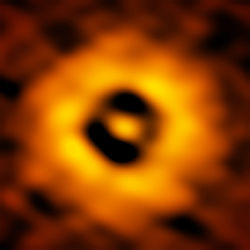Top Qs
Timeline
Chat
Perspective
TW Hydrae
T Tauri star in the constellation Hydra From Wikipedia, the free encyclopedia
Remove ads
TW Hydrae is a T Tauri star approximately 196 light-years away[1] in the constellation of Hydra (the Sea Serpent). TW Hydrae is about 80% of the mass of the Sun, but is only about 5-10 million years old. The star appears to be accreting from a protoplanetary disk of dust and gas, oriented face-on to Earth, which has been resolved in images from the ALMA observatory. TW Hydrae is accompanied by about twenty other low-mass stars with similar ages and spatial motions, comprising the "TW Hydrae association" or TWA, one of the closest regions of recent "fossil" star-formation to the Sun.
Remove ads
Stellar characteristics

TW Hydrae is a pre-main-sequence star that is approximately 80% the mass of and 111% the radius of the Sun. It has a temperature of 4000 K and is about 8 million years old. In comparison, the Sun is about 4.6 billion years old[7] and has a temperature of 5778 K.[8] The star's luminosity is 28% (0.28x) that of the Sun, equivalent to that of a main-sequence star of spectral type ~K2. However, the spectral class is K6.
The star's apparent magnitude, or how bright it appears from Earth's perspective, is 11.27. It is too dim to be seen with the naked eye.
Remove ads
Planetary system
Summarize
Perspective
The star is known to host one likely exoplanet, TW Hydrae b.
Protoplanetary disk
Previously disproven protoplanet
In December 2007, a team led by Johny Setiawan of the Max Planck Institute for Astronomy in Heidelberg, Germany announced discovery of a planet orbiting TW Hydrae, dubbed "TW Hydrae b" with a minimum mass around 1.2 Jupiter masses, a period of 3.56 days, and an orbital radius of 0.04 astronomical units (inside the inner rim of the protoplanetary disk). Assuming it orbits in the same plane as the outer part of the dust disk (inclination 7±1°[11]), it has a true mass of 9.8±3.3 Jupiter masses.[11][12] However, if the inclination is similar to the inner part of the dust disk (4.3±1.0°[13]), the mass would be 16+5
−3 Jupiter masses, making it a brown dwarf.[13] Since the star itself is so young, it was presumed this is the youngest extrasolar planet yet discovered, and essentially still in formation.[14]
In 2008 a team of Spanish researchers concluded that the planet does not exist: the radial velocity variations were not consistent when observed at different wavelengths, which would not occur if the origin of the radial velocity variations was caused by an orbiting planet. Instead, the data was better modelled by starspots on TW Hydrae's surface passing in and out of view as the star rotates. "Results support the spot scenario rather than the presence of a hot Jupiter around TW Hya".[15] Similar wavelength-dependent radial velocity variations, also caused by starspots, have been detected on other T Tauri stars.[16]
New study of more distant planet
In 2016, ALMA found evidence that a possible Neptune-like planet was forming in its disk, at a distance of around 22 AU.[17]
Outflow of an embedded protoplanet
In 2024 observations with ALMA showed sulfur monoxide representing an outflow from an embedded protoplanet. The position of the brightest emission coincides with a planet-carved dust gap at 42 au. Previously this gap was associated with the formation of a super-earth and modelling of the outflow velocity, the researchers estimate a mass of about 4 earth-masses. The mass accretion of this embedded protoplanet is constrained to between 3 x10−7 and 10−5 MJ/year.[10]
Detection of methanol
In 2016, methanol, one of the building blocks for life, was detected in the star's protoplanetary disk.[18][19][20][21][22][23][24][25]
Remove ads
Gallery
- Shadow moving counterclockwise around a gas and dust disc.[26]
- Simulation based on Hubble observations.
- TW Hydrae protoplanetary disc.
- This illustration is based on NASA/ESA Hubble Space Telescope images of a gas and dust discs encircling the young star TW Hydrae.
- This artist’s impression video shows the protoplanetary disc around TW Hydrae. The organic molecule methyl alcohol (methanol) has been found in this disc.
Notes
- From , where is the luminosity, is the radius, is the effective surface temperature and is the Stefan–Boltzmann constant.
Remove ads
References
External links
Wikiwand - on
Seamless Wikipedia browsing. On steroids.
Remove ads










